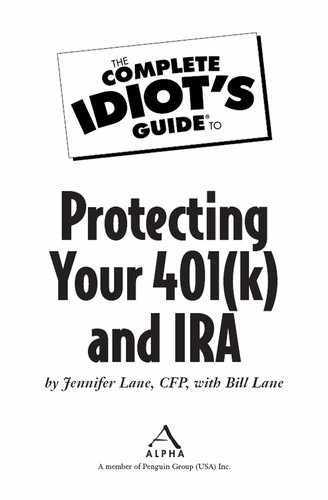0%
110Chapters
0-1Hours read
0kTotal Words
Book Description
No need to panic.
Written by financial experts, this essential guide tells investors how to keep their investments safe in this difficult economy. Readers will discover how economic upswings and downturns affect investment plans-and what can be done to anticipate these trends; changes in investment rules and guidelines and their impact on 401(k)s and IRAs; and how to identify the proper investment decisions for their needs.
*On NPR's March 7, 2008, broadcast of All Things Considered, discussion centered on new weaknesses in the economy, and quite a bit of time was devoted to a story on how to protect your 401(k)
*In 2000, 40 million 401(k) participants had an average account balance of about $50,000 and total assets of $2 trillion
Table of Contents
- Title Page
- Copyright Page
- Dedication
- Introduction
- Part 1 - Understanding Your Accounts
- Part 2 - Tending Your Nest Egg
- Part 3 - Ready for Retirement
- Part 4 - After You’re Gone
- Appendix A - Glossary
- Appendix B - Web Resources
- Calculators and Asset Allocation Tools
- Account Aggregators
- Asset Allocation and Investing
- Retirement Planning
- Hiring Professional Advice
- Financial Sites, Newsletters, and Blogs
- Online Money Market Accounts
- Real Estate
- Taxes and Information on Retirement Plans
- Estate Planning and Elder Law
- Online Education
- Divorce
- Widowhood
- Appendix C - Staying the Course When the Economy Gets Choppy
- 1. Understand your account statements2. Don’t change your plan contributions3. Turn off the “auto-rebalance” feature4. Don’t buy anything you don’t need5. Track expensesUnderstand Your Account Stateme
- Don’t Change Your Plan Contributions
- Turn Off the “Auto-Rebalance” Feature
- Don’t Buy Anything You Don’t Need
- Track Your Expenses
- What If Your Partner Disagrees?
- Index
